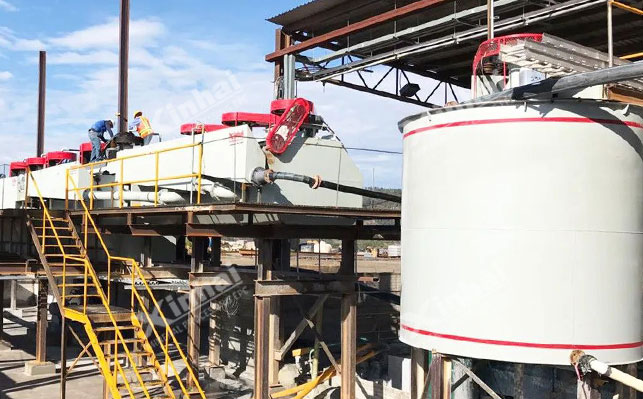With the continuous popularization of the concept of carbon neutrality and new energy technologies, the development and utilization of cobalt ore resources are receiving more and more attention. In nature, most cobalt minerals are associated with iron, copper, nickel and other metal minerals, and single cobalt minerals are relatively rare. Common cobalt-bearing metal deposits include copper-nickel-cobalt deposits, copper-cobalt deposits, iron-cobalt deposits and cobalt-earth deposits. This article will show you the beneficiation process of common cobalt deposits from the perspective of these four types of deposits.

In copper-nickel-cobalt deposits, the main metal minerals are copper, cobalt, nickel, etc. The main gangue minerals are quartz, muscovite, biotite, plagioclase, serpentine, etc. There are many kinds of sulfide minerals. At the same time, copper, nickel and cobalt are closely related to arsenic minerals, and there are many independent minerals of arsenic.
Copper-nickel-cobalt ore is generally treated by mixed flotation process to obtain a relatively large concentration of copper-cobalt-nickel mixed concentrate, which can be priced and sold at the same time, and can also be smelted. It should be noted that this ore contains a lot of easily floatable gangue minerals, and it is easy to produce secondary slime during the grinding process, which will affect the enrichment of copper, nickel and cobalt concentrate. The flocculating deslime-mixed flotation process can be selected to concentrate copper, nickel and cobalt concentrate with high concentration by mixed flotation, and then separate and extract cobalt minerals by hydrometallurgy.

There are two kinds of copper-cobalt deposits, one often contains copper, lead, zinc, silver and other polymetallic minerals, and the other contains copper, cobalt, uranium and other minerals. The two kinds of deposits are different in the separation process, most of which are determined according to the difference in the floatability of copper and cobalt minerals, generally including priority flotation process and mixed flotation process.
When treating copper-cobalt ore with preferential flotation process,
generally, copper is preferentially flotation and cobalt is re-floated. Lime is
used as inhibitor, YK1-11 is used as copper collector, and butyl xanthate is
used as cobalt collector to obtain copper concentrate and cobalt-sulfur
concentrate respectively.
When using the mixed flotation process to separate
copper-cobalt ore, butyl xanthate can be used as the collector and BKNL as the
regulator for flotation to obtain the copper-cobalt mixed coarse concentrate.
During the separation, sodium silicate, lime and other inhibitors are added to
inhibit gangue minerals to obtain the copper-cobalt mixed concentrate.

The main cobalt-bearing minerals in iron-cobalt deposits are generally pyrite, pyrrhotite and a small amount of chalcopyrite, etc. The main gangue minerals are quartz, pyrite, epidote, biotite, chlorite, etc. The composition is relatively complex, and the cobalt minerals are generally closely associated with iron minerals.
This kind of ore can be treated by flotation method. First, sulfide and magnetite can be separated, and then a small amount of chalcopyrite, pyrite and pyrrhotite can be separated by flotation method. At the same time, magnetite can be separated by magnetic separation to obtain copper concentrate, cobalt-sulfur concentrate and iron concentrate respectively.

Cobalt ores are mostly produced in weathered deposits. In addition to cobalt, they also contain manganese, copper, nickel, iron and other metal elements. The recoverable part of the ore is often dominated by the compound formed by manganese oxide and cobalt oxide. Cobalt minerals are closely associated with manganese minerals, which contain a lot of clay, iron slime and limonite. Generally, manganese minerals and cobalt minerals are recycled together.
In terms of beneficiation method, single or combined beneficiation process
can be selected for cobaltic ore. The single beneficiation method includes
gravity separation, magnetic separation, flotation, acid leaching, etc. The
combined beneficiation method includes calcination-flotation method and acid
leaching-flotation method, of which the acid leaching-flotation method is
currently the most commonly used beneficiation method for cobaltic ores.
The
above is about the beneficiation process of common cobalt ore. The composition
of cobalt minerals is complex, so it is more necessary to consider the
comprehensive recovery and utilization of different mineral resources when
formulating the beneficiation plan. Therefore, in the actual production,
according to the different types and composition of cobalt-bearing ore, there
are also differences in the beneficiation process plan. Therefore, it is
necessary to first analyze the properties of the cobalt deposit components, and
determine a scientific and reasonable beneficiation process plan through tests
to avoid economic losses and resource waste caused by improper process plan.